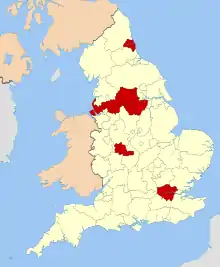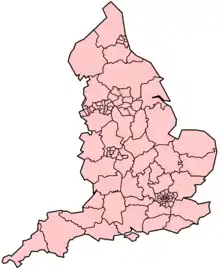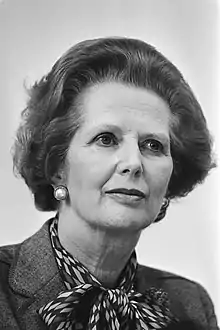Local Government Act 1985
The Local Government Act 1985 is an Act of Parliament in the United Kingdom. Its main effect was to abolish the six county councils of the metropolitan counties that had been set up in 1974, 11 years earlier, by the Local Government Act 1972, along with the Greater London Council that had been established in 1965. In their place many single purpose authorities known collectively as 'joint authorities' were established for fire service, police and passenger transport. An ad hoc education authority was established for Inner London and a planning authority for Greater London. The legislation permitted councils to form 'joint arrangements' for waste disposal and other services that they wished to provide together. Time-limited residuary bodies were created to dispose of the assets of the former authorities.
| Act of Parliament | |
.svg.png.webp) | |
| Long title | An Act to abolish the Greater London Council and the metropolitan county councils; to transfer their functions to the local authorities in their areas and, in some cases, to other bodies; and to provide for other matters consequential on, or connected with, the abolition of those councils. |
|---|---|
| Citation | 1985 c.51 |
| Territorial extent | England and Wales |
| Dates | |
| Royal assent | 16 July 1985 |
| Commencement | 1 April 1986 |
Status: Current legislation | |
| Text of statute as originally enacted | |
| Text of the Local Government Act 1985 as in force today (including any amendments) within the United Kingdom, from legislation.gov.uk. | |


Background
Following the victory of the Conservative Party at the 1979 general election, Margaret Thatcher's government were involved in a series of high-profile disputes with the GLC and Metropolitan County Councils. All of the authorities were controlled by, or came under the control of the opposition Labour Party during Thatcher's first term. The Conservative manifesto for the 1983 general election pledged their abolition, describing the councils as "a wasteful and unnecessary tier of government".[1] Having won a landslide victory in the 1983 General Election, the government published a white paper in October of that year, Streamlining the cities. Its proposals formed the basis of the Local Government Bill.[2]
Provisions
The core provision, section 1, stated that "the Greater London Council; and the metropolitan county councils" shall cease to exist. It came into effect on 1 April 1986, with some powers being devolved to the metropolitan boroughs themselves and London boroughs and others to joint authorities (such as for fire or police purposes) consisting of members of each of the metropolitan district councils within each county. At the time of the Act, one third of the population of England were living in Greater London and the metropolitan counties.[3]
Time-limited residuary bodies were created to handle the disposal of the councils' assets. Part III of the Act also set up the Inner London Education Authority, which had previously been a committee of the GLC responsible for education in Inner London, as a directly elected body. This was to remain in existence for only three years.
The Local Government Act 1972 allowed councils to voluntarily form joint committees to provide services together and the Local Government Act 1985 extended this principle by directing local authorities to form some shared arrangements whilst permitting them to form others as they wished.
Local authorities abolished by Part I
Six metropolitan county councils were abolished and the local authority of Greater London.
Joint committees established by Part II
- Joint planning committee for Greater London
- Greater Manchester Trading Standards Joint Committee
- Merseyside County Trading Standards Joint Committee
- South Yorkshire Trading Standards Joint Committee
- Tyne and Wear Trading Standards Joint Committee
- West Midlands Trading Standards Joint Committee
- West Yorkshire Trading Standards Joint Committee
Joint arrangements established by Part II
- East London Waste Authority
- Greater Manchester Waste Disposal Authority
- Merseyside Waste Disposal Authority
- North London Waste Authority
- Western Riverside Waste Authority
- West London Waste Authority
Ad hoc authorities established by Part III
Note: The outer London borough councils and metropolitan district councils were already education authorities.
Joint authorities established by Part IV
A number of single purpose authorities were established, collectively known as joint authorities in the legislation.
- Fire and civil defence authorities
- Greater Manchester Fire and Civil Defence Authority
- London Fire and Civil Defence Authority
- Merseyside Fire and Civil Defence Authority
- South Yorkshire Fire and Civil Defence Authority
- Tyne and Wear Fire and Civil Defence Authority
- West Midlands Fire and Civil Defence Authority
- West Yorkshire Fire and Civil Defence Authority
- Passenger transport authorities
- Greater Manchester Passenger Transport Authority
- Merseyside Passenger Transport Authority
- South Yorkshire Passenger Transport Authority
- Tyne and Wear Passenger Transport Authority
- West Midlands Passenger Transport Authority
- West Yorkshire Passenger Transport Authority
Note: London Regional Transport was established separately by the London Regional Transport Act 1984.
- Police authorities
- Greater Manchester Police Authority
- Merseyside Police Authority
- Northumbria Police Authority
- South Yorkshire Police Authority
- West Midlands Police Authority
- West Yorkshire Police Authority
Note: The Metropolitan Police was under the control of the Home Office and unaffected by the legislation.
Ad hoc bodies established by Part V
- London Boroughs Grants Committee
Residuary bodies established by Part VII
- Greater Manchester Residuary Body
- London Residuary Body
- Merseyside Residuary Body
- South Yorkshire Residuary Body
- Tyne and Wear Residuary Body
- West Midlands Residuary Body
- West Yorkshire Residuary Body
Ad hoc bodies established by Part IX
- London Research Centre
References
- Colin Turpin and Adam Tomkins (2007). British Government and the Constitution: Text and Materials. Cambridge University Press. pp. 248–249. ISBN 9780521690294.
- "Streamlining the Cities". Hansard 1803–2005. Parliament of the United Kingdom. Retrieved 7 May 2012.
- Hampton, W., Local Government and Urban Politics, (1991)
